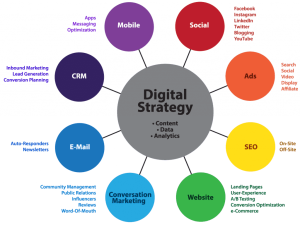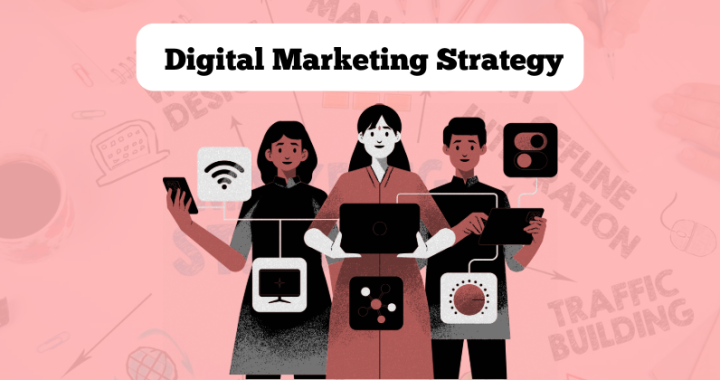In the current digital era, a strong digital marketing plan is necessary for firms to prosper and maintain their competitiveness. In addition to providing direction for marketing initiatives, a well-organized strategy guarantees efficient use of available resources in order to meet organizational objectives. This comprehensive guide explores the definition of a digital marketing strategy, its essential elements, how to create one, and why it’s financially worthwhile.
What is a strategy for digital marketing?
 A detailed plan outlining how a company will use digital technologies and online platforms to accomplish its marketing objectives is called a digital marketing strategy. Search engines, email, social media, content marketing, and other platforms are included. The objectives, target market, and available resources of the company are all taken into consideration when developing a digital marketing plan, which guarantees this
A detailed plan outlining how a company will use digital technologies and online platforms to accomplish its marketing objectives is called a digital marketing strategy. Search engines, email, social media, content marketing, and other platforms are included. The objectives, target market, and available resources of the company are all taken into consideration when developing a digital marketing plan, which guarantees this
Components of Digital Marketing Strategy
Objectives and Goals:-
The first stage in developing a digital marketing plan is to identify specific, measurable targets. Objectives ought to be Time-bound, Relevant, Measurable, Achievable, and Specific (SMART). Increasing website traffic, producing leads, raising awareness of the brand, and improving conversion rates are a few examples of objectives.
Targeted Audience:-
Any digital marketing plan must have a thorough understanding of its target demographic. To do this, in-depth buyer personas representing the ideal clientele must be created. These personas contain details about demographics, hobbies, actions, problems, and shopping patterns. Understanding the target market enables marketing initiatives to be more suited to their requirements and preferences.
Competitive Analysis:-
Examining the digital marketing tactics of rival companies can give you important information about what works and what doesn’t in the market. This include researching the websites, content, social media profiles, SEO rankings, and online marketing initiatives of rival businesses. Finding market gaps and opportunities is made easier with the aid of competitive analysis.
Channel Selection:-
Choosing the appropriate digital channels is critical. Depending on the target audience and business objectives, the following channels may be used:
- SEO: Increasing a website’s visibility on search engines.
- Content marketing: Developing valuable content to captivate and engage your target audience effectively and efficiently.
- Social Media Marketing: Promoting content and interacting with the audience on social platforms.
- Email Marketing: Sending targeted messages to nurture and retain customers.
- PPC Advertising: Using paid ads to drive traffic and conversions.
- Affiliate and Influencer Marketing: Partnering with affiliates and influencers to expand reach.
Content Strategy:-
Content is the foundation of digital marketing. A well-defined content strategy specifies the sort of material to be developed, its structure, themes to be covered, and distribution channels. Effective content strategies include:
- Audience-centric: Designed to meet the needs and interests of the audience.
- Value-driven: Provide useful knowledge and solutions.
- Consistency: Regularly publishing high-quality content.
Budgeting and Resource Allocation:-
Determining a budget and allocating resources efficiently ensures the sustainability of marketing efforts. This includes:
- Content creation costs
- Advertising spend
- Tools and software
- Personnel and training
Performance Metrics and Analytics:-
Setting key performance indicators (KPIs) and using analytics tools to track performance is crucial for measuring success and making data-driven decisions. Common metrics include:
- Website traffic and user behavior
- Conversion rates
- Customer acquisition cost (CAC)
- Return on investment (ROI)
Benefits of a Digital Marketing Strategy
Enhanced Focus and Direction:-
A clear strategy provides a focused direction for marketing efforts, ensuring all activities align with business goals and reducing the risk of wasted resources.
Better Audience Engagement:-
Understanding the target audience allows for tailored marketing efforts that resonate with potential customers, leading to higher engagement and conversion rates.
Competitive Edge:-
Analyzing competitors and capitalizing on market opportunities can give businesses a competitive advantage, helping them stand out in a crowded market.
Improved Resource Management:-
A strategic approach ensures efficient use of resources, maximizing the impact of marketing efforts and optimizing ROI.
Measurable Outcomes:-
Digital marketing provides the ability to track and measure the effectiveness of campaigns in real-time, allowing for continuous optimization and improved results.
Developing a Digital Marketing Strategy
Define your goals:-
Begin by establishing clear, quantifiable goals that are aligned with your business objectives. Determine your goals and set clear metrics to track success.
Know Your Audience:-
Conduct rigorous research to better understand your target audience. Create thorough buyer profiles to guide your marketing efforts and guarantee they connect with your target demographic.
Analyze competitors:-
Conduct a competitive study to determine what your competitors are doing well and where there is room for distinction. Use this information to improve your plan.
Choose the Right Channels:-
Choose the digital platforms that are most relevant to your audience and goals. To efficiently reach your target audience, consider combining SEO, content marketing, social media, email marketing, PPC, and other tactics.
Create a content plan:-
Create a content plan that specifies the sort of material you will produce, the themes you will cover, and the distribution methods. Ensure that your material is valuable, relevant, and consistent.
Allocate budget and resources:-
Determine your budget and deploy resources accordingly. Ensure you have the appropriate equipment, software, and personnel to carry out your approach efficiently.
Implement and monitor:-
Execute your digital marketing strategy and employ analytics tools to monitor results. Monitor critical indicators and adapt your plan as needed to achieve the best results.
Optimize Continuously:-
Regularly assess and analyze the effectiveness of your internet marketing initiatives. Make data-driven changes to improve results and remain on top of industry trends.
Real-World Applications
Small Business Growth:-
A small business selling handmade crafts can leverage digital marketing to reach a broader audience. By using social media advertising, content marketing, and SEO, the business can increase online visibility, attract more customers, and drive sales.
Enterprise-Level Impact:-
A multinational corporation can use a comprehensive digital marketing strategy to optimize global marketing efforts. By leveraging data analytics, personalized marketing, and cross-channel campaigns, the corporation can enhance brand presence, increase customer engagement, and drive revenue growth across different regions.
Conclusion
A well-crafted digital marketing strategy is essential for businesses looking to succeed in today’s digital landscape. It provides a clear roadmap for achieving marketing goals, ensures efficient use of resources, and enables businesses to connect with their target audience effectively. By understanding the key components, benefits, and steps to develop a digital marketing strategy, businesses can create a path to sustained growth and success.
In conclusion, investing in a digital marketing strategy is not just beneficial but necessary in the modern business environment. It enables businesses to navigate the complexities of the digital world, stay competitive, and achieve long-term success.
